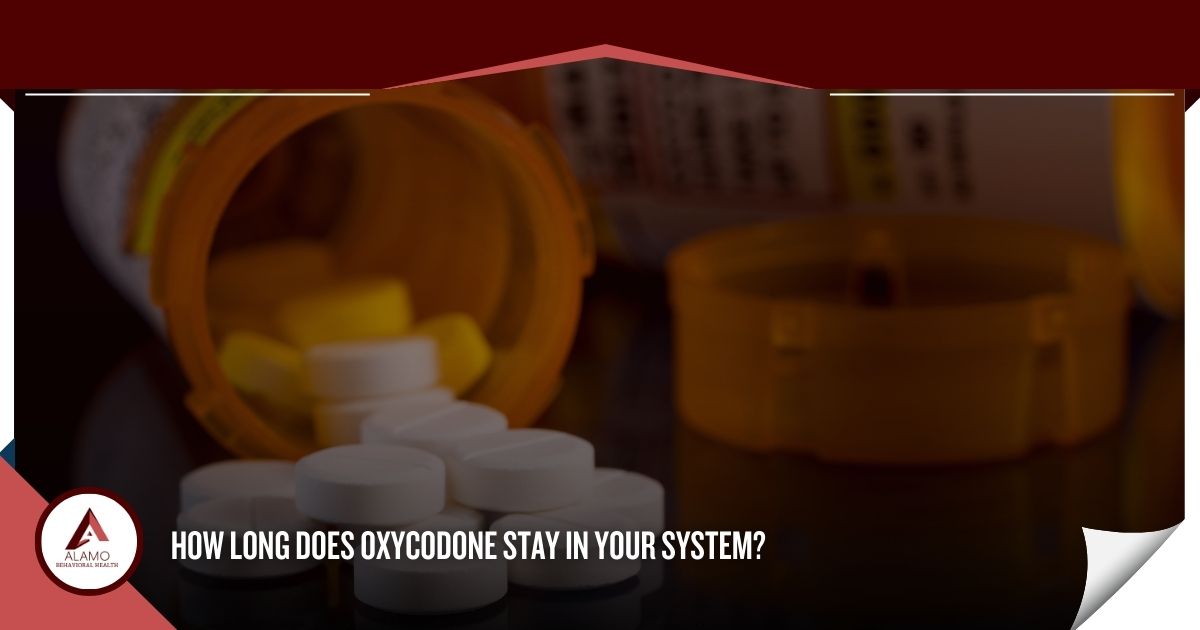
The length of time oxycodone stays in your system can vary depending on certain personal factors. Your age, the amount of oxycodone you use, and your kidney and liver functioning can all affect how your body metabolizes oxycodone.
This article will explore oxycodone abuse and addiction, how long oxycodone can be detected in various drug screenings, and what withdrawal symptoms to expect when oxycodone is eliminated from the body.
If you or someone you love struggles with addiction to oxycodone, contact the Alamo Behavioral Health specialists to learn about our controlled substance abuse treatment programs or to schedule an intake assessment.
Oxycodone Abuse and Addiction: An Overview
Oxycodone is an opioid pain reliever doctors prescribe to treat chronic pain. People may also take prescription oxycodone to manage pain after a medical procedure or surgery.
While opioids like oxycodone provide good pain relief, these potent drugs also have the potential for misuse and addiction. People may enjoy the euphoric or sedating effects of oxycodone and want to take it differently than their doctor told them to.
Oxycodone misuse includes:
- Taking a larger dose
- Taking it more often
- Taking it for longer periods
- Ingesting it differently than prescribed, such as crushing and snorting tablets
- Using it recreationally–meaning without a prescription
Oxycodone works by binding to opioid receptors in areas of the brain involved in pain control, emotional regulation, and pleasure. Heavy or prolonged opioid use can lead to physical dependence, addiction, and other long term complications.
How Long Do the Effects of Oxycodone Last?
Doctors often start patients on a very low dose of an opioid pain reliever and then slowly build up a dose until they experience adequate pain relief. Oxycodone typically begins to work within about 30 minutes. People experience peak oxycodone levels within about 3 to 4 hours.
A common way to determine how long a drug remains in the body is to measure its half-life. The half-life of a drug is measured by how long it takes for the body to eliminate half of the drug.
The half-life of oxycodone is just over 3 hours. Extended-release formulations of oxycodone may have a half-life of between 4.5 and 5.6 hours. Generally, it takes about 24 hours for the body to metabolize and clear all oxycodone from its systems.
How Long Can Drug Testing Detect Oxycodone?
Although the body eliminates oxycodone in about 24 hours, drug screening tests can detect it for longer periods. Here is an overview of how long specific tests can detect oxycodone.
Saliva tests
Saliva tests are relatively sensitive and able to detect oxycodone in the body for up to four days after a person’s last dose.
Urine tests
Urine tests are among the most common forms of drug screening for employment or in a treatment program. They can detect oxycodone in urine for 3 to 4 days after a person’s last dose.
Blood tests
Blood tests are typically able to detect oxycodone for about 24 hours after a person’s last dose.
Hair tests
Hair tests may be able to detect oxycodone for up to 90 days after a person’s last dose.
Generally, drug screening tests can detect oxycodone in the body for much longer periods than people feel its effects. Doctors typically recommend taking oxycodone every 4 to 6 hours, or every 12 hours if you take an extended-release version.
Understanding Oxycodone Withdrawal
When someone uses oxycodone for a long period or misuses it, their body may develop a physical dependence on it. If a person with physical addiction to oxycodone suddenly stops taking it, they will likely experience a range of uncomfortable withdrawal symptoms, including:
- Nausea
- Vomiting
- Diarrhea
- Depression
- Anxiety
- Coughing
- Runny nose
- Watery eyes
- Sweating
- Shaking
- Elevated heart rate
- Mood swings
- Irritability
- Poor concentration
- Body aches
The severity and timeline of a person’s symptoms depend on how long they have been abusing oxycodone, other substances they use, their general health, and more.
While each person experiences withdrawal differently, symptoms tend to follow a standard timeline. Here is a quick overview of what to expect at each stage of the oxycodone withdrawal timeline.
Days 1-2
People may begin to experience withdrawal symptoms within 8 to 12 hours of their last dose. Early symptoms include:
- Fatigue
- Headache
- Flu-like body aches
- Anxiety
- Fatigue
- Heavy sweating
- Runny nose
Relapse is common during the first few days as symptoms progressively intensify.
Days 3-5
Withdrawal symptoms peak during this stage. People often experience cramps, intense nausea, and shaking in addition to earlier symptoms. The risk of relapse is high.
Days 6-7
As physical symptoms gradually begin to improve, people may experience debilitating depression and anxiety. Many people have mood swings and intense irritability, as well as exhaustion and sleep disturbances.
Support and treatment are essential during oxycodone and withdrawal. People with oxycodone addiction must seek care from a medically supported detox program to have the best outcomes.
Find Oxycodone Addiction Treatment
If you or someone you love needs help to overcome oxycodone addiction, you are not alone. Reach out to the team at Alamo Behavioral Health now to learn about our treatment programs or to explore our other supportive programs.



